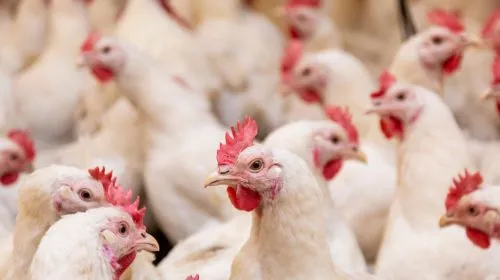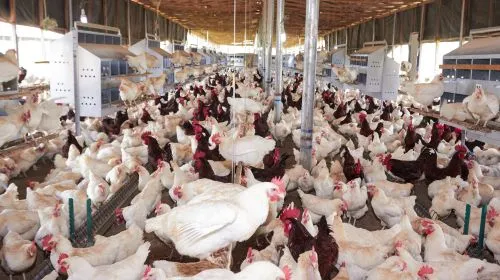What is Poultry farming, and how to do poultry farming?

Poultry farming is one of the successful and profitable techniques in India by which small farmers or businessmen start their setup on a low scale and later convert it into a high-scale.
Poultry farming is one of the most successful agricultural practices in India, offering a highly profitable and consistently productive farm. It involves raising domestic birds such as chickens, ducks, quails, or turkeys for meat and eggs, making it a viable option.
Demand for protein-rich food is rapidly increasing in India, and people are increasingly seeking to incorporate it into their daily diets. On the other hand, it is becoming a source of income for small farmers and entrepreneurs who lack the capital to start their own businesses, as it doesn't require much space or significant investment. Starting a small business with a small investment and regular inputs can generate substantial income.
India's egg and meat markets are also rapidly expanding, with people demanding high-quality, protein-rich foods, such as eggs and chicken, as they are a healthy, high-protein diet. This is why the agricultural sector's GDP is growing day by day, which is a significant factor for the agricultural sector.
What is poultry farming in India?
Poultry farming refers to the act of keeping and breeding birds either as sources of eggs, meat, or chicks. Chicken is the most popular poultry bird, with some farmers also rearing ducks, turkeys, and quails.
The poultry farming in India is broadly divided into two large groups:
Broiler Farming—Keeping chickens to be used as meat.
Layer Farming—Hens are kept to produce eggs.
This business is capable of being conducted on a small scale and a large scale, depending on the capital, land, and technical knowledge. It provides a stable stream of income, as the poultry products are needed throughout the year.
Types of Poultry Farming in India
Poultry farming can be done in several ways, depending on the kind of birds one wants to keep:

1. Broiler Poultry Farming:
Specializes in the manufacture of chicken meat.
The growth of broiler chickens has a faster rate, and the chickens attain market size in 6-8 weeks.
Common broiler breeds: Cobb 500, Ross 308, and Vencobb.
2. Layer Poultry Farming:
Focuses on egg production.
Hens begin to lay eggs at the age of 18-20 weeks and go on to a maximum of 72 weeks.
Popular breeds: White Leghorn, Rhode Island Red, and Hy-Line Brown.
3. Breeder Farming
Incidentally, it involves raising quality chicks in favor of other farmers.
Needs additional investment and expertise.
4. Free-range or Organic Poultry Farming.
Birds are left to fly and feed naturally.
Eggs and meat are not chemical, and they sell at a high price in the market.
5. Duck, Quail and Turkey Farming
Increasing niche market demands.
Duck eggs contain more nutrients, and quail meat can be regarded as high quality.
Poultry farming in India: How to start the business (Step-by-step)
The introduction of a poultry farm needs adequate planning, investments and management. The steps necessary for beginners are as follows:
Step 1: Research and Business Planning
Research the local market demand, the poultry industry, and its supply chain before investing.
Compile an elaborate business plan that includes:
- Farming type (broiler/layer/organic)
- Land requirement
- Feed cost
- Equipment & labor
- Marketing and profit estimation.
This assists in obtaining bank loans or NABARD subsidies.
Step 2: Select the Right Breed of poultry
- High-yielding breeds are essential in the choice of breeds.
- In the case of broilers: Select Cobb, Ross or Hubbard.
- On layers: Select Lohmann Brown, Hy-Line or BV 300.
- Only certified hatcheries shall be used to buy chicks to have disease-free stock.
Step 3: Choose a Farm site and construct a poultry shed
A good location should have:
- Proper space and air conditioning.
- Availability of clean water and electricity.
- Out of the polluted and noisy places.
Shed construction tips:
- South-North to enhance the sunlight.
- Keep at the right temperature (22°C - 30°C).
- Ventilate with wire mesh.
- Supplies clean bedding and drainage.
Step 4: Nutrition and Feeding Management
Feed costs are approximately 70% of the total costs, and therefore, their effective management is important.
Feed should include:
- Protein: Fish meal, soybean meal.
- Carbohydrates: Maize, wheat bran.
- Vitamins and minerals: Premixes, limestone, and grit.
- Always provide clean water.
Feed schedule:
- Starter feed (0-4 weeks)
- Grower feed (5-8 weeks)
- Finisher or layer feed (9+ weeks)
Step 5: Health & Biosecurity
Good profit and productivity are guaranteed by healthy birds.
Keep the following biosecurity precautions:
- Vaccinate birds regularly (Ranikhet, Marek, Fowlpox).
- Cover sheds with a disinfectant once a week.
- Avoid overcrowding.
- Limit access of visitors to avoid infection.
Common diseases in poultry:
- Ranikhet disease
- Avian influenza
- Fowl cholera
A veterinary specialist should be consulted regarding vaccination schedules.
Step 6: Marketing & Sales
To be successful in business, marketing plays a vital role.
Sell your products through:
- Local markets
- Wholesalers and retailers
- Online delivery services, restaurants, and hotels.
Product differentiation can be done by promoting your products as farm-fresh or organic eggs/meat, and this will raise profit margins.
Benefits of Poultry Farming

- Large market demand for eggs and meat.
- Does not need as much land and investment as dairy or goat farming.
- Fast returns (within 2-3 months).
- It may be initiated as a small home-based business.
- Creation of jobs in the rural regions.
- Problems with Poultry Farming
- Outbreaks of diseases that result in massive devastation.
- Increasing prices of feeds and medicines.
- Egg/meat price movements in the market.
- Need for skilled management.
Solutions:
Modernize farming practices, use hygiene, and diversify against risk with organic or quail farming.
Supports and Schemes offered by the Government for Indian Farmers
India has several government schemes to assist the new poultry farmers:
1. NABARD Poultry Farming Subsidy:
This is a quartered 25-33% subsidy on poultry farm establishment.
Open to the small and large farmers.
2. PM Kisan Sampada Yojana:
Cold storage, meat processing and value addition.
3. National Livestock Mission (NLM):
Grants to cover the production of feed, hatchery installation and facilities.
It can be applied by the farmers via their District Animal Husbandry Department or NABARD regional office.
Conclusion:
Poultry farming is the best farming method considering today's era. By doing this, you can sell your produce not only in India but also outside India. Every small-scale farmer in India is doing poultry farming, and it is profitable too.
In this blog, we have clarified all the points related to poultry farming, like how poultry farming is done and what poultry farming is in India, what its advantages and disadvantages are, how it can be done, and how many types of farming are done in it.
The methods of doing it have been explained step-by-step in a good manner. Along with this, how can you take advantage of the schemes given by the government, etc.? Information related to poultry farming is provided to you by Tractorbird.com. We provide you with the information related to farming.











